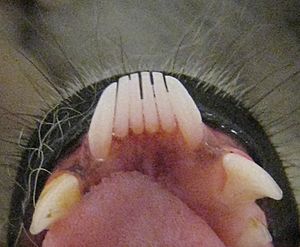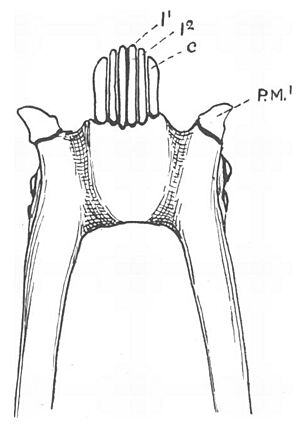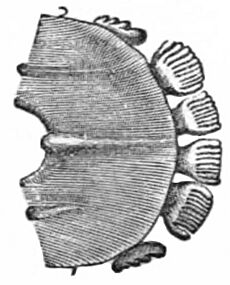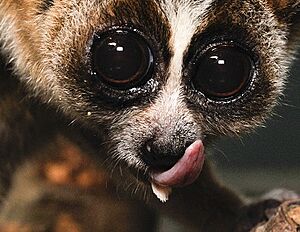Toothcomb facts for kids
A toothcomb (also called a tooth comb or dental comb) is a special set of teeth found in some mammals. It is made of a group of lower front teeth that are long, thin, and packed closely together, looking and working much like a hair comb.
This unique dental tool is found in primates like lemurs and lorisoids, as well as in treeshrews, colugos, hyraxes, and some African antelopes. These animals did not all inherit the toothcomb from a common ancestor. Instead, many developed it on their own through a process called convergent evolution, where different species evolve similar features to solve similar problems, like grooming their fur.
Contents
Different Animals, Similar Tools
A toothcomb is a great example of how animals adapt to their needs. While several types of animals have a toothcomb, the way it's built can be very different.
- Lemurs and Lorises: In these primates, the toothcomb is a defining feature. It is made of their lower incisors and canine teeth all pointing forward.
- Colugos (Flying Lemurs): Their toothcomb is unique. Instead of having spaces between the teeth, each incisor tooth is serrated, with up to 15 sharp points. This makes each tooth its own mini-comb.
- Treeshrews: Their toothcomb is made only from their incisor teeth, not their canines.
- Antelopes and Hyraxes: These animals also have comb-like teeth that they use for grooming, showing how useful this tool can be.
Even some ancient mammals that lived over 50 million years ago, like Chriacus, had a toothcomb, which they also evolved independently.
What a Toothcomb Looks Like
The most studied toothcomb belongs to lemurs and their relatives.
The Lemur's Toothcomb

A typical lemur toothcomb has six teeth: four incisors and two canines. These teeth are tilted forward at the front of the lower jaw. Because the lower canines are part of the comb, the first premolar teeth behind them are usually shaped like canines and do the job of piercing and gripping.
This special arrangement means the lower front teeth don't meet the upper front teeth. In many lemurs, the upper incisors are very small or even missing completely.
Keeping the Comb Clean
How does an animal clean a comb that's part of its mouth? Lemurs and lorises have a clever solution: a sublingua, or "under-tongue." This is a smaller, muscular part of the tongue that is tipped with hard, serrated points. It works like a toothbrush, raking between the teeth of the toothcomb to remove trapped hair and dirt.
Not All Toothcombs Are the Same
Even among lemurs, there are differences:
- The indri and sifaka have a stronger, wider toothcomb with only four teeth. This helps them with tougher tasks like scraping bark.
- The aye-aye is a very unusual lemur that lost its toothcomb. Instead, it has two large, rodent-like front teeth that grow continuously.
What Is a Toothcomb Used For?
The toothcomb is a multi-purpose tool that helps animals survive.
A Built-in Grooming Tool
The main job of the toothcomb is grooming. An animal will lick its fur and then run its toothcomb through it to keep it clean, smooth, and free of pests.
Scientists confirmed this by looking at toothcombs under powerful scanning electron microscopes. They found tiny, parallel grooves on the sides of the teeth. These scratches were made by strands of hair being pulled through the comb over and over again.
African antelopes also use their toothcombs for grooming. They sweep their heads upward, combing their fur to remove dirt and parasites.
More Than Just a Comb
Besides grooming, the toothcomb has other important uses:
- Getting Food: Mouse lemurs and sifakas use their toothcombs as a scoop to eat fruit pulp. Other animals, like galagos and fork-marked lemurs, use them to scrape tree sap and gum, which are sugary treats.
- Gouging Bark: Sifakas use their strong toothcombs to scrape bark off trees before rubbing scent from a gland on their chest to mark their territory.
The Mystery of the First Toothcomb
Scientists who study fossils, called paleontologists, have long debated how and why the toothcomb first evolved in the ancestors of lemurs and lorises.
The fossil record shows that the earliest primates did not have this feature. For a long time, there was a gap in the fossil record, making it hard to know when the toothcomb appeared. However, the discovery of a 40-million-year-old fossil primate in Egypt, named Karanisia, provided a big clue. Karanisia is the oldest known primate with a clear toothcomb.
This discovery suggests that the ancestors of lemurs and lorises have been in Africa for a very long time, even though their fossil record is rare.
Grooming or Food?
A big question for scientists is what the toothcomb was originally for.
- Some scientists argue it evolved for grooming. They point out that the teeth are long and delicate, perfect for combing fur but not for tough jobs like scraping hard wood.
- Other scientists believe it evolved for getting food. They note that many "primitive" lemurs use it to scrape sap, and that feeding is a very powerful force in evolution.
Today, most scientists believe the toothcomb's first job was grooming. Later, some animal groups adapted this useful tool for other tasks, like scraping food. This shows how evolution can repurpose a feature for new and helpful functions.




